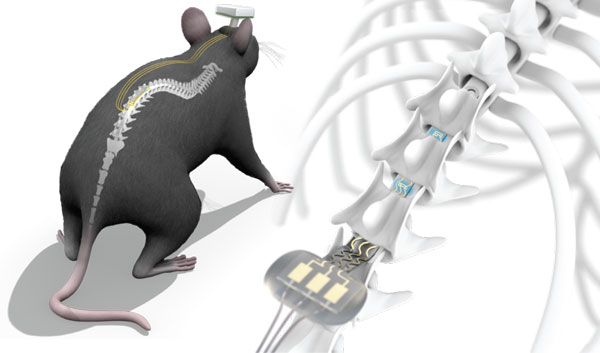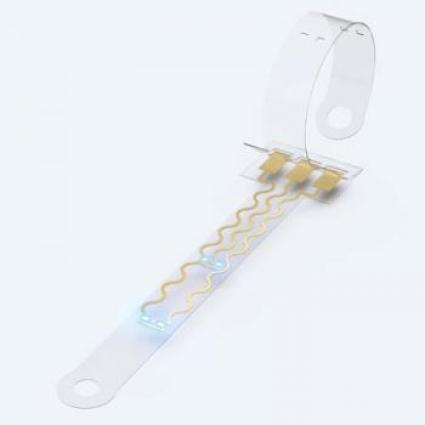In collaboration with Professor Stéphanie Lacour’s group at EPFL and Professor Qiuting Huang’s group at ETH Zurich, we developed a spinal implant for mice integrating microLEDs for photostimulation. Developing implants for the spinal cord of mice is a unique challenge because of the limited space in the vertebral column due to mice’s small physique and the extensive displacement of the soft spinal cord within the hard bony vertebral column during natural movement. We found a way to encapsulate miniaturized LEDs in a flexible implant that is thin yet sturdy enough to be applied on the surface of a mouse’s spinal cord by sliding it underneath the vertebrae along the entire lumbar section. We combined this implant with a wireless electronic circuit that can be used to switch the LEDs ON and OFF with extreme precision.

Figure 1: Overview of the implanted spinal array incorporating microLEDs connected to a wireless headstage for precise control of photostimulation, including a zoom on the insertion of the implant over the spinal cord within the vertebral column.
 This system can also run autonomously, for example the LEDs can be switched ON in response to muscular activity or other physiological signals. Systems like this are generally needed for answering research questions that require mice to move about freely and perform complex tasks such as swimming or climbing a rope. My HFSP Long-Term Fellowship enabled me to use this new implant to interrogate the contribution of specific subsets of neurons to walking and I found that sensory inputs are absolutely essential for the recovery of walking after paralysis.
This system can also run autonomously, for example the LEDs can be switched ON in response to muscular activity or other physiological signals. Systems like this are generally needed for answering research questions that require mice to move about freely and perform complex tasks such as swimming or climbing a rope. My HFSP Long-Term Fellowship enabled me to use this new implant to interrogate the contribution of specific subsets of neurons to walking and I found that sensory inputs are absolutely essential for the recovery of walking after paralysis.
Figure 2: Schematic of the spinal implant showing 4 microLEDs embedded within high-conducting and stretchable gold interconnects encapsulated in a soft PDMS matrix.
Our technology creates new opportunities to develop therapeutic applications using photostimulation to activate or inhibit specific neurons in the spinal cord. There is still a long way until these technologies can be used in humans, but it may eventually allow doctors to treat chronic pain, improve spasticity or even treat paralysis.
|
HFSP award information Long-Term Fellowship (LT001278/2017-L) - project: Restoration of voluntary motor control after severe spinal cord injury with neurorehabilitation |


































